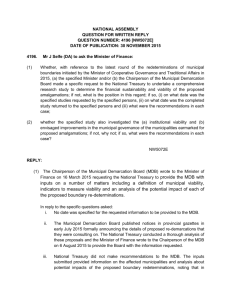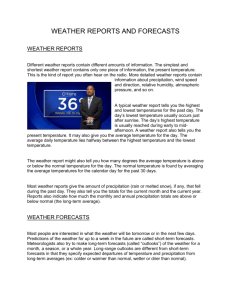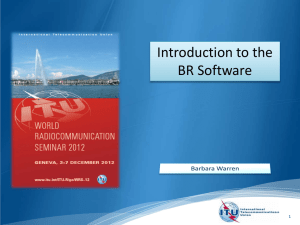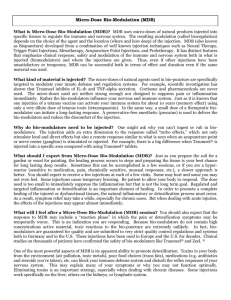Risks to Murray-Darling Basin Water Resources Program
advertisement
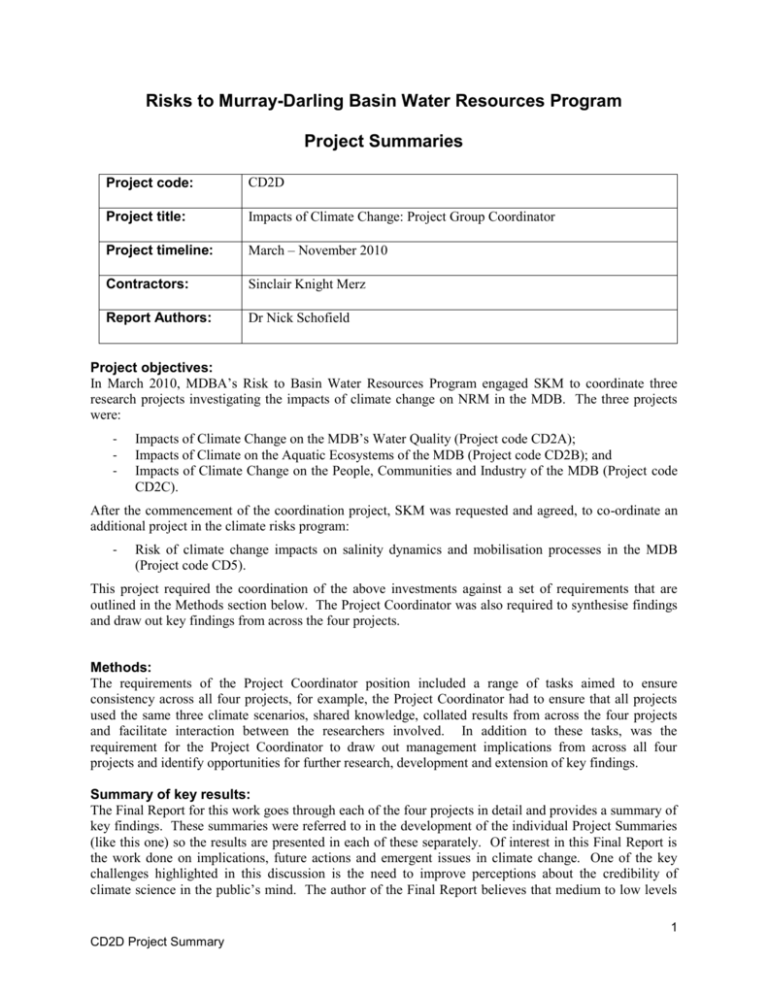
Risks to Murray-Darling Basin Water Resources Program Project Summaries Project code: CD2D Project title: Impacts of Climate Change: Project Group Coordinator Project timeline: March – November 2010 Contractors: Sinclair Knight Merz Report Authors: Dr Nick Schofield Project objectives: In March 2010, MDBA’s Risk to Basin Water Resources Program engaged SKM to coordinate three research projects investigating the impacts of climate change on NRM in the MDB. The three projects were: - Impacts of Climate Change on the MDB’s Water Quality (Project code CD2A); Impacts of Climate on the Aquatic Ecosystems of the MDB (Project code CD2B); and Impacts of Climate Change on the People, Communities and Industry of the MDB (Project code CD2C). After the commencement of the coordination project, SKM was requested and agreed, to co-ordinate an additional project in the climate risks program: - Risk of climate change impacts on salinity dynamics and mobilisation processes in the MDB (Project code CD5). This project required the coordination of the above investments against a set of requirements that are outlined in the Methods section below. The Project Coordinator was also required to synthesise findings and draw out key findings from across the four projects. Methods: The requirements of the Project Coordinator position included a range of tasks aimed to ensure consistency across all four projects, for example, the Project Coordinator had to ensure that all projects used the same three climate scenarios, shared knowledge, collated results from across the four projects and facilitate interaction between the researchers involved. In addition to these tasks, was the requirement for the Project Coordinator to draw out management implications from across all four projects and identify opportunities for further research, development and extension of key findings. Summary of key results: The Final Report for this work goes through each of the four projects in detail and provides a summary of key findings. These summaries were referred to in the development of the individual Project Summaries (like this one) so the results are presented in each of these separately. Of interest in this Final Report is the work done on implications, future actions and emergent issues in climate change. One of the key challenges highlighted in this discussion is the need to improve perceptions about the credibility of climate science in the public’s mind. The author of the Final Report believes that medium to low levels 1 CD2D Project Summary of confidence characterise climate science, and that this is largely as a result of the complex systems being studied and the strong reliance on computer modelling for future projections relying on large number of assumptions. One of the points raised in a number of the climate change projects is the limited capacity of Global Climate Models (GCMs) to provide accurate climate forecasts at the scale of the MDB is constrained. GCMs also do not adequately take into account regional modes of climate variability (prominent in the Australian context), land surface atmosphere coupling and some feedback processes in the carbon cycle. This further limits their capacity to provide realistic forecasts at the MDB scale. This author notes that the issue of forecast quality is critical to assessment of future impacts of climate change in the MDB as climate inputs drive most impact assessments. Modellers have tried to address this by developing future climate scenarios that capture both a range of future Greenhouse Gas emission scenarios and a range of forecasts by the different GCMs. Such scenarios are useful for asking ‘what-if’ questions, and putting reasonable bounds on future possibilities. Despite this scenario approach, it is proposed in the Final Report that uncertainty in climate change forecasting needs to be addressed more explicitly and communicated more effectively. Some of the other areas highlighted in the Implications and Future Actions section of the report and worthy of consideration by the MDBA are: - There are many sources of uncertainty in models to be considered, including: key processes selected and omitted; different representations/codifications of processes; selection of model parameter values; representation of interactions between processes; inclusion of important feedback mechanisms; treatment of processes not fully understood; effects of different model structures; impacts of using different antecedent conditions; error cascades in down-scaling; and selection of future emission scenarios. These and other factors can create a wide range in the uncertainty of forecasts. Current methods to account for uncertainty in climate projections are also limited, for example use of statistics applied to ensembles of projections based on intrinsically different models, or assumptions relating to commonality in forecasts from different models equating to accuracy of forecasts. Hence greater effort to characterise and communicate uncertainty is needed. - Most users of climate information seek forecasts at a particular spatial scale of relevance. This scale is often small in relation to the forecast capability of GCMs. Down-scaling techniques have been used to assist in translating GCM forecasts to local scales, but it should be noted that these techniques do not improve the quality of the GCM forecasts used. - The natural variability of the Australian climate, and that of the MDB, is amongst the highest in the world. This is in part due to a number of regional scale climate ‘modes’ that affect the climate over weeks, months, seasons, years and decades. The modes include: ENSO, IOD, SAM, IPO/ PDO and STR amongst others. Each of these modes affects climate outcomes over different spatial and temporal scales and some interact with each other. There are also indications that some of these modes are themselves being influenced by global warming. Research on these aspects of climate variability and interactions with climate change are progressing, but much more effort is required in this domain. - Landscape type, vegetation, soil moisture, fire, irrigation and orography interact with the large scale climate forcing in complex ways. Whilst these are primarily second order effects, more research is required on the role of each aspect in climate outcomes. - Warming has been occurring in the MDB since the 1950s and numerous climate trends are evident in climate observations. It is proposed that more emphasis should be placed on observations of climate change in the instrumental and palaeoclimate records as a means of understanding and assessing impacts of past and future climate change, particularly given the limitations on future GCM forecasts and their inability to account for some current observed trends such as autumn rainfall decline. 2 CD2D Project Summary - The scientific evidence for global warming and ongoing changes in the climate system is very strong, and the potential short, medium and long term consequences range from substantial to catastrophic. Climate change and climate variability are arguably the most important drivers of future change to the natural resources of the MDB and may have significant impacts on industries and communities. Clear, well-argued priorities for research to meet the needs of all sectors of the community should be agreed and financially supported. Comparisons with other projects: This Final Report draws together the results of four projects and provides a summary table that reflects the current status of knowledge, including areas where knowledge is well established, still contested and relatively poorly addressed. The table is useful and covers the range of climate drivers and impacts on different ecological and human ‘communities’ addressed in the four projects (see pages 97-102 of the project final report). Knowledge gaps identified: These are discussed in the Results section above. Implications for policy: These are discussed in the Results section above. Recommended Communication Approach: The Final Report does not need to be published as a stand-alone document as it more for internal use. However, the summary Table of findings from across the four projects in the Implications and Future Actions chapter is useful and may be worth publishing as a separate ‘fast facts’ on likely climate change impacts. 3 CD2D Project Summary



